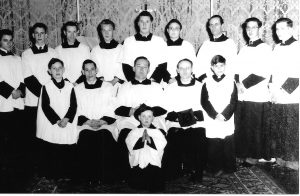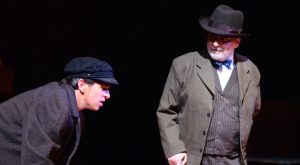Why I Like to Tell Stories

I was baptized as an infant and I was taught from my earliest years to say my prayers. But as a family we did not normally go to church—probably because my father was Roman Catholic and my mother Church of England, and in those days neither denomination looked kindly on mixed marriages. Then for some reason, as I grew older, I did decide to go to church, and certainly my parents made no objection. I do not know quite what it was that led me first as a child to that strange pseudo-gothic edifice at the corner of Gloucester Terrace and Bishop’s Bridge Road, and later as a teenager to confirmation classes conducted by Father Walter Cole at Saint Mark’s, Marylebone Road. Nor do I remember much about the classes, save that we seemed to spend a lot of time talking about the atom bomb. Of course I believe that on one level my being drawn to the church was a work of the Holy Spirit, but that does not alter the oddness of it all on the merely human level.
I can, however, identify some of the reasons why I stayed in the church, first to become a committed communicant and later to become a priest.
On the one hand, there were the priests I knew, first Father Cole, who was indeed a good and kind man, and then Father John Crisp, who was both good, kind, and great, and quite simply the finest parish priest I have ever known. He had some splendid curates: notably, Father Derek Price and Father Michael Farthing, both of whom were wonderfully supportive to us young people. There were also laypeople, especially Ray Thompson, head server at St Mark’s, always genial and kind, yet setting us high standards for liturgy and for life. I joined the servers and had a wonderful time as a teenager. These men served the church, and none of them should be forgotten–certainly not by me! Through them the church taught me the catholic faith.

On the other hand, there were books. And that, for me, above all meant stories: works of Christian imagination and sometimes of Christian fantasy. Writers from the past—Dante, Chaucer, and Shakespeare—provided me with much basic furniture, but there were also more recent figures who were important to me: Anthony Trollope, E. Nesbit, Charles Williams and Dorothy Sayers. And there were others still more recent whom in time I even got to see with my own eyes and hear with my own ears—C. S. Lewis, J. R. R. Tolkien and Neville Coghill. These storytellers in their different ways not only shaped the content of my faith but also coloured and polished it. From them I learned that orthodoxy was not only true but also beautiful; that goodness was not only right but also joyful; and that evil not merely bad but boring. From them I came to understand why Jesus is called not just ὁ ποιμὴν, the shepherd, but ὁ ποιμὴν ὁ καλός—the beautiful shepherd. Saul Bellow said that a writer is a reader moved to emulation, and that certainly resonates with me. Part of my answer to the question, “Why do I like to tell stories?” is that when I had read everything these writers had to offer, when I had watched every episode of “New Tricks”, I still wanted more: and there was apparently no way to that except, for better or ill, to try to do it myself!
And behind all these storytellers, as I came gradually to realize, lies the Christian story itself. The Apostolic and Nicene Creeds are not stories and the Rule of Faith is not a story. But the Creeds and the Rule of Faith imply a story and are meaningless without one. To that story the Scriptures of Old and New Testaments bear witness. The Bible, for all the apparent incoherence and contradiction that characterize it at particular points (core testimony and countertestimony, as Walter Breuggemann has taught us to call them[1]), nonetheless tells a story. It is a narrative with a beginning, a middle, and an end. And that is not an accident.[2] That story is the true divine comedy, the greatest of all stories. Ours are indeed, in Gisela Kreglinger’s phrase, “storied revelations.”[3]
In the light of that story, and given its utter centrality for us, we might ask—and indeed some have asked—how does it happen that we also have the ability to compose and tell stories of our own? How do we dare to do that? More precisely, how do I dare to do that? What right have I to do it? And why do I delight in in it?
We have this ability, as I suppose, precisely because in us the tongue, the breath, the mind and the emotions all go together. We see the ocean, blue and sparkling, and we know that the sight of it delights us. But then, in our minds and imaginations at least, we have power over that. We may imagine an ocean that is like crystal, still as glass. Or blood red like a ruby. Reality can and probably should inform us. But it does not have to constrain or constrict us. We can create another world, and make it as we will, with trees that have leaves of gold and animals that talk. And then, as J. R. Tolkien, one of our best and best-known storytellers, put it, “new form is made… Man becomes a sub-creator.” Of course, and as Tolkien pointed out, like all our powers, this power can be used for good or ill, in sickness or in health. But that does not mean that we may or should abandon it. Nicolas Berdyaev made much the same point: “Man is a creator not only in the name of God but in the name of the devil as well. This complicates the problem of creativity. But we must not be led astray into reaction against the creative spirit in general, by the power of Satanic creativity in the world of today.” As we look back at the history of the twentieth century and so far of the twenty-first, Berdyaev’s words, written in 1926 in the author’s preface for the German edition, have a prophetic ring.[4]
We dare to tell stories and even have a right to do so precisely because the true divine comedy is a story without end and all our stories, even our fictional stories, find their place and redemption in it. Of course our stories need redemption just as we do. As a hearer of stories and even in a small way myself a teller of them, I am well aware that even the best of our stories is stained with the marks of our sinfulness. And even the worst (I hope) glimmers with some spark of hope for grace. The incarnation of the Word in Jesus Christ means that God’s own Word has been inextricably and graciously bound both to that sinfulness and to that hope. And the resurrection and ascension of Jesus Christ mean that he is not simply a figure of the past but a presence now and a figure in the present age, still bound to us, redeeming our sinfulness and offering ground for our hope. His story is not over and never will be. The rite for the Burial of the Dead in the Book of Common Prayer begins with the anthem, “I am Resurrection and I am Life, says the Lord.” A certain kind of biblical literalism wants us to say, “Ah, no! Jesus said these words to Martha, when he was on the way to Lazarus’ tomb. It is all in the past.”[5] To which faith in the risen Christ replies, “On the contrary, our exalted Lord is Lord of the Church now, and so he speaks to us now. Jesus Christ is the same yesterday, today, and forever, which means that what the fourth evangelist says Jesus said, Jesus also says. Our stories are contained in his story, and his promise abides for us.”

Last but not least, I would say that we delight to compose our own stories because God is a creator who delights in what has been created (Gen. 1:31), and we are created in God’s image. We too, as Dorothy Sayers said, have “the mind of the maker.” Some us, of course, have this particular gene, or whatever it is, in spades. I don’t know why. But I do know that in a very small, minor way, I am one of them. I recently had the delight of playing the Narrator in Theatre Sewanee’s 2016 production of Neil Simon’s The Good Doctor. In the wonderfully gentle, funny opening soliloquy that Simon gives to the Narrator, he says, “I ask myself a question… what force is it that compels me to write so incessantly, day after day, page after page, story after story…. And the answer is quite simple…. I have no choice…. I am a writer…. Sometimes I think I may be mad…” [6] Actors should always try to find something in the role they are playing with which they can connect. In this case I had no difficulty at all. Those lines describe me perfectly! And that is why I like to tell stories.
[1] Walter Breuggemann, Theology of the Old Testament: Testimony, Dispute, Advocacy (Minneapolis: Fortress, 1997), 117-403.
[2] I owe this thought to Northrop Frye: see Frye, The Great Code: The Bible and Literature (San Diego: Harcourt, 1981), xiii; I have also written on the issue myself: see my Listening to the Bible: The Art of Faithful Biblical Interpretation (Oxford, 2013), 66-76.
[3] Gisela H. Kreglinger, Storied Revelations: Parables, Imaginations, and George MacDonald’s Christian Fiction.DDCT 9. (Eugene, Oregon: Pickwick, 2013).
[4] J. R. R. Tolkien, Tree and Leaf (London: George Allen and Unwin, 1964), 25; Nicolas Berdyaev, The Meaning of the Creative Act, Donald A. Lowrie, transl. (California: Semantron Press, 2009 [London: Victor Gollancz, 1955]), 9.
[5] Alas, the Church of England’s The Alternative Service Book 1980 fell into just this trap, in contrast to the “Burial of the Dead” in the 1662 Book of Common Prayer: see David Brown, Discipleship and Imagination: Christian Tradition and Truth (Oxford: Oxford University Press, 2000), 6.
[6] Dorothy L. Sayers, The Mind of the Maker (London: Methuen, 1941); Neil Simon, The Good Doctor (London and Hollywood, California: Samuel French, 1974), 7-8.

